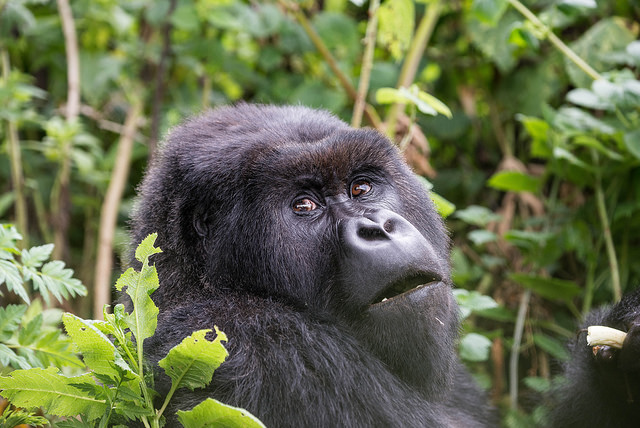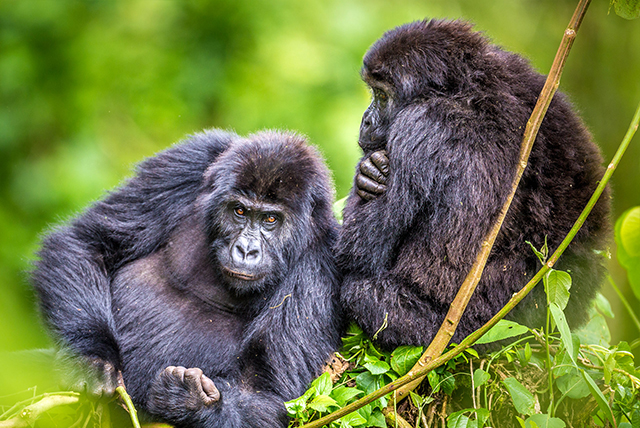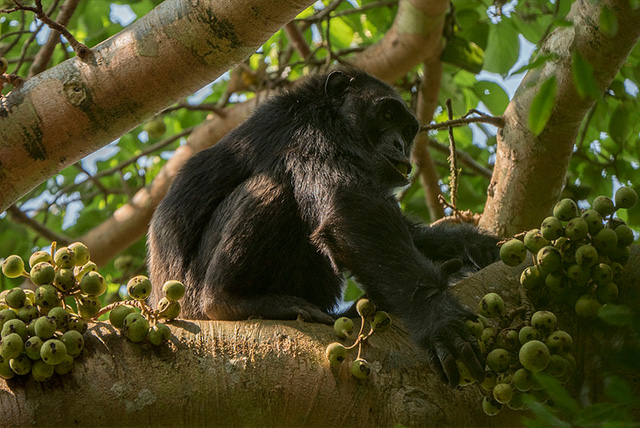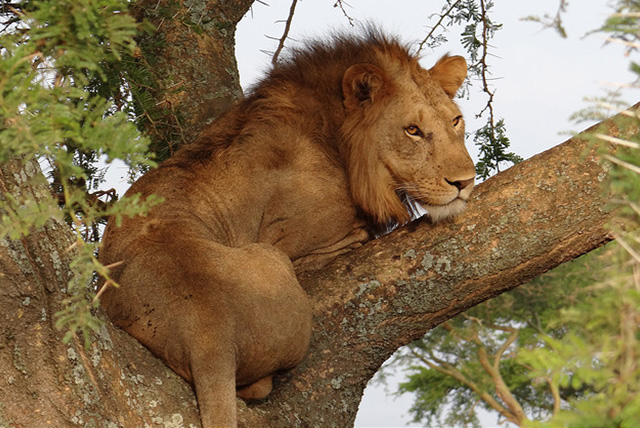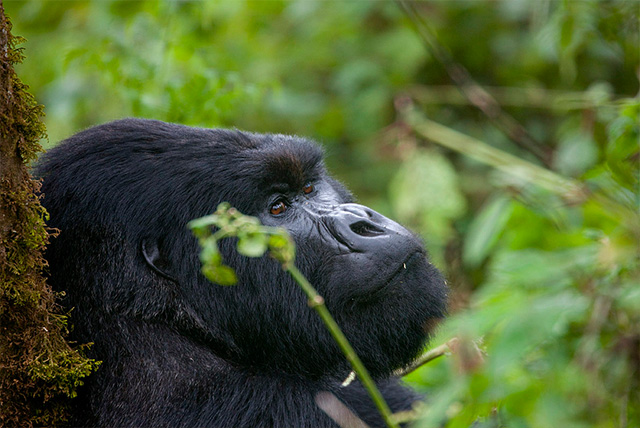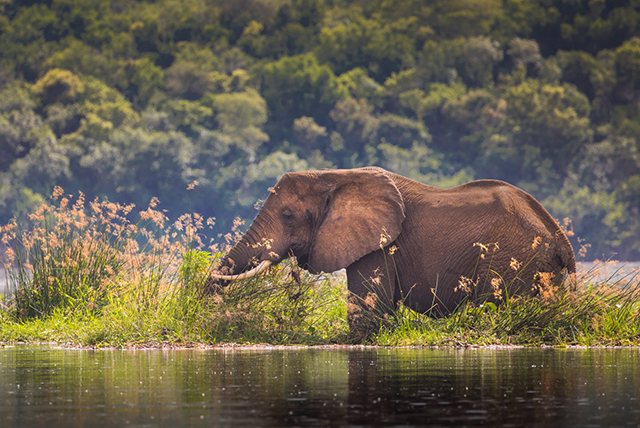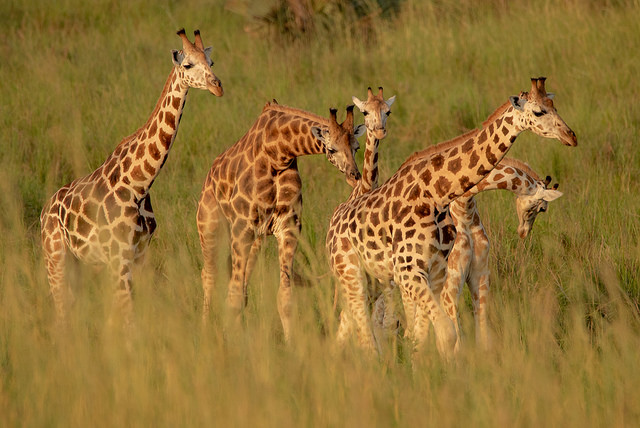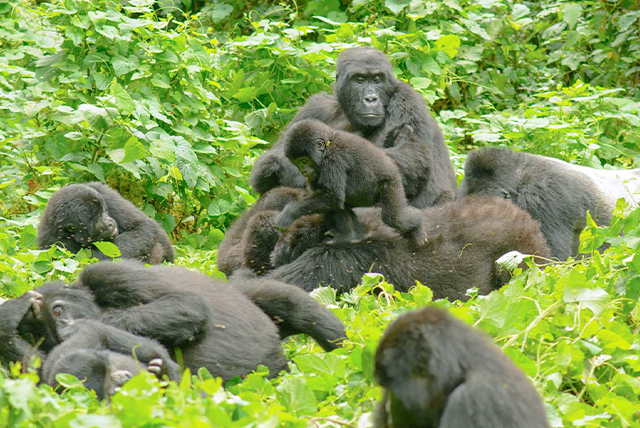Great Apes of Africa
Take a safari holiday in Kenya, where safari travel first began. Often combining Kenya’s major attractions with Tanzania and the tropical
The Majestic Great Apes of Africa: A Comprehensive Guide and Travel Plans
The Great Apes of Africa: An Exciting Guide and Travel Plans. Meeting Africa’s great apes in their wild habitats is truly one of life’s most remarkable experiences. Discover the incredible great apes of Africa, uncovering where to locate them and the most thrilling ways to observe them in their wild environment.
Mountain gorillas (Gorilla beringei beringei) inhabit two distinct regions. One finds themselves in the Bwindi Impenetrable Forest National Park in Uganda, which seamlessly extends into the Sarambwe Forest in DR Congo. The other is located in the captivating Virunga Volcanoes conservation area, encompassing three national parks across Rwanda, Uganda, and eastern DR Congo. The Grauer’s gorilla, also known as the Eastern Lowland gorilla (Gorilla beringei graueri), resides exclusively in the eastern lowlands. Over the past few decades, the populations and ranges of all great ape species have significantly diminished. All of the great apes are classified as Endangered or Critically Endangered on the IUCN Red List of Threatened Species, and their populations are declining, with the exception of mountain gorillas.
In West Africa, the population of Eastern Lowland gorillas stands at around 2,000, while the Cross River gorillas are critically low, with fewer than 300 remaining. Approximately 6,600 Sumatran orangutans are believed to still roam freely in their natural habitat. The Western Lowland gorilla (Gorilla gorilla gorilla) can be discovered in the vibrant landscapes of Equatorial Guinea, Cameroon, Gabon, Congo, DR Congo, and the Cabinda region of Angola.
These 11 regions of woodland lie along the border that separates Nigeria and Cameroon. These lands are inhabited by the Cross River gorilla (Gorilla gorilla diehli). The Pan paniscus monkey has held a spot on the IUCN Red List as an Endangered Species since 1996. This species is exclusively located in the heart of the Congo Basin in the Democratic Republic of Congo. It thrives in small groups south of the Congo River. Pan troglodytes, the chimpanzee, roams across 21 countries in Equatorial Africa. Nonetheless, it has been listed as Endangered on the IUCN Red List since 1996.
The Eastern chimpanzee (Pan troglodytes schweinfurthii) stands out as one of the four fascinating subspecies of the chimpanzee. The Central chimpanzee (Pan troglodytes troglodytes) is yet another fascinating species. The Cameroon–Nigeria chimpanzee (Pan troglodytes ellioti) is a fascinating species that inhabits the vibrant landscapes of West Africa. These four subspecies inhabit a vast expanse of Africa, ranging from the southern regions of Senegal and Guinea in West Africa to the western areas of Uganda and Tanzania in East Africa, traversing the Congo Basin. The orangutan stands out as the sole great ape residing in Asia. It is believed that it once roamed freely throughout Indochina.
Today, two distinct kinds thrive on the islands of Sumatra and Borneo. They are divided into three distinct sub-species of Bornean orangutan.
Exploring the Great Apes of Africa
Chimpanzees
COMMON NAME: Chimpanzees
SCIENTIFIC NAME: Pan troglodytes
CLASSIFICATION: Mammals
DIET: Diverse and varied
GROUP NAME: Explorers
EXPECTED LIFE SPAN IN NATURE: 45 years
DIMENSION: Four to 5.5 feet
WEIGHT: 70 to 130 pounds
DIMENSIONS IN COMPARISON TO A 6-FT MAN:
Chimpanzees, much like humans, are social creatures, can live beyond 50 years, and offer enduring care for their offspring. Indeed, chimpanzees and humans share nearly all of our genes, highlighting the fascinating connection between our species.
In their native Central African forest habitat, chimpanzees thrive high in the trees, where they embrace the excitement of their surroundings. While they have the ability to walk upright for distances of up to a mile, chimpanzees usually prefer to navigate on all fours when they return to the ground. Sticks are used to extract termite mounds, while clusters of leaves soak up water.
Gorillas are fascinating creatures that inspire a sense of wonder and excitement.
Debate continues among experts regarding the classification of the world’s two smallest populations of mountain gorillas, which are subspecies of the eastern gorilla, and whether they should be recognized as two separate species. Just over half of the inhabitants reside in the Virunga Mountains, a stunning range of dormant volcanoes that marks the boundary between the DRC, Rwanda, and Uganda. There’s more to uncover in Uganda’s Bwindi Impenetrable National Park. For many years, there was a prevailing belief that mountain gorillas might vanish by the close of the twentieth century, facing numerous perilous challenges since their discovery in 1902, such as conflict, poaching, habitat loss, and disease.
Mountain gorillas, as the name implies, dwell in rugged mountainous areas cloaked in thick forests, typically found at elevations ranging from 8,000 to 13,000 feet. In comparison to other remarkable apes, they are distinguished by their denser and more plentiful fur. Thanks to their fur, they thrive in environments where the temperatures often plunge below freezing. However, gorillas have faced increasingly perilous and, at times, deadly situations as humans have encroached upon their territory, driving them further and higher into the mountains for extended periods.
Thanks to conservation initiatives, the subspecies’ once-doubtful future has embarked on an exciting journey toward improvement in recent years. Mountain gorilla populations have thrived in both countries, overcoming challenges such as human population growth, poaching, and civil unrest.
Encountering a Wild Mountain Gorilla – The Day I Found Myself in Its Path
COMMON NAME: Mountain Gorilla
SCIENTIFIC NAME: Gorilla beringei beringei
CLASSIFICATION: Mammals
DIET: Varied
GROUP NAME: Expedition, ensemble
USUAL LIFE SPAN IN NATURE: 35 years
DIMENSIONS: Height when standing: 4 to 6 feet
WEIGHT: 300 to 485 pounds
DIMENSIONS COMPARED TO A 6-FOOT INDIVIDUAL:
This massive ape, one of the largest primates currently roaming the earth, belongs to a subspecies of the eastern gorilla. Unlike their lowland cousins, these apes boast longer hair and shorter limbs; they feature large hands and feet, a broad chest, and strong arms. Their thick black hair equips them to brave the chill of colder climates.
The Virunga Mountains in central Africa shelter around half of the planet’s remaining mountain gorillas, with their population in the hundreds. Gorilla beringei is the scientific name for mountain gorillas, a fascinating subspecies of the genus Gorilla. Perched high in the mountains, their home sits at an impressive altitude of 8,000 to 13,000 feet, just as their name implies.
The majestic Eastern gorilla
The eastern lowland gorilla, commonly known as Grauer’s gorilla, stands as the largest among the four subspecies categorized as gorillas. A robust physique, large hands, and a compact nose are the unique traits that differentiate it from other gorillas. Like other gorilla subspecies, eastern lowland gorillas mainly feast on fruit and various plant materials in their diet. This is even more remarkable considering their relatively small size.
The mountain gorilla and the eastern lowland gorilla have faced significant challenges due to the prolonged periods of civil unrest in the Democratic Republic of the Congo (DRC). The lush lowland tropical rainforests in the eastern Democratic Republic of the Congo serve as the vibrant home for the eastern lowland gorilla. In the last fifty years, its territory has diminished from 8,100 square miles, roughly the size of Massachusetts, to around 4,600 square miles today. At present, this subspecies may only inhabit a mere 13% of its former territory. During the mid-1990s, the population of eastern lowland gorillas was around 17,000. Nevertheless, scientists estimate that the population has plummeted by over fifty percent since then. For many years, accurately counting the animals has been a challenge due to the turmoil that has plagued the region.
Amidst the chaos, the gorillas have faced the threat of poaching, even within the bounds of Kahuzi-Biega National Park, where the largest population of protected eastern lowland gorillas resides. Alongside the secretive mines that emerged, the park faced incursions from rebels and poachers. Despite the challenges, park staff are actively striving to reclaim the property with the support of the World Wildlife Fund and various other organizations.
Western lowland gorilla
The western lowland gorilla is the most widely spread subspecies of gorilla, boasting the largest population among its kind. Some of the countries where vibrant populations thrive include Cameroon, the Central African Republic, the Democratic Republic of the Congo, and Equatorial Guinea. Moreover, significant regions of Gabon and the Republic of Congo are inhabited by diverse populations. The western lowland gorillas inhabit some of the most dense and inaccessible rainforests in Africa, making their actual population a mystery. There are still notable populations, including those that inhabit wetlands that are cut off from each other and in the lush, marshy forests of the Republic of Congo.
Western lowland gorillas stand out from other gorilla subspecies due to their slightly smaller stature, unique brown-grey fur, and striking auburn chests, along with several other notable traits. They possess smaller ears and larger skulls, featuring brow ridges that stand out more than those found in humans. Despite a significant population, the western lowland gorilla continues to face a decline. The gorilla population has faced a dramatic decline of over sixty percent in the last two to twenty-five years, largely due to poaching and the emergence of disease. Even if all the threats to western lowland gorillas were removed, researchers believe it would still take about seventy-five years for the population to bounce back.
Silverback Gorilla
The silverback mountain gorilla is an adult male mountain gorilla distinguished by the striking silvery hair adorning its back. They are renowned for their displays of fierce competition and authority, showcasing behaviors such as whooping, charging, chest pounding, tree slapping, and, on rare occasions, physical duels. Alongside this remarkable milestone of maturity, they are also recognized for these intriguing behaviors.
The typical silverback boasts a weight of 430 pounds (195 kilograms) and stands at a height of 5 feet (1.5 meters). Silverbacks possess incredible strength, capable of hoisting over 1,763 pounds (800 kilograms) of dead weight with ease. About double the amount of a weightlifter who has undergone proper training. In the heart of the wilderness, a silverback harnesses its incredible power to topple trees, revealing the delicious fruits hidden within. Mountain gorillas play a crucial role in Virunga, significantly influencing the ecology of their unique environment.
Cross River Gorilla
While they may resemble western lowland gorillas, Cross River gorillas are a distinct subspecies of the western lowland gorilla facing a critical risk of extinction. Yet, the shape of their skulls sets them apart, and their teeth vary in size. Their fur often showcases shades that are more vibrant or muted compared to the eastern gorillas.
Similar to their counterparts, the Cross River gorillas thrive in social groups, where the dominant male silverback takes on the role of the leader, guiding the assembly through their daily lives. Their group size tends to be smaller compared to other subspecies, typically consisting of fewer than six members in each group. Their diet is predominantly made up of vibrant plant life, featuring an array of fruits, tender shoots, and lush leaves.
Concerning this rare subspecies of gorilla, there is limited knowledge available, aside from the reality that their population is small and their habitat is significantly fragmented, potentially endangering their survival. The Gorilla Organisation, through the Ymke Warren Memorial Conservation Award, offers financial assistance to African primatologists engaged in research on the Cross River gorillas.
There are three types: the Bornean, the Sumatran, and the Tapanuli, which was recently recognized as a new species in 2017. The islands of Borneo and Sumatra are unique destinations where these magnificent apes roam freely in their natural habitat. All three orangutan species face a serious challenge to their existence. Some estimates suggest that there are fewer than 800 Tapanuli orangutans, less than 14,000 Sumatran orangutans, and just over 100,000 Bornean orangutans remaining in the world. Nonetheless, determining the precise population of orangutans that continue to thrive in the world remains a challenge. Bornean orangutans sport deeper red coats and rounder cheeks compared to their Sumatran relatives. While they might seem alike with their fluffy ginger fur, there are intriguing differences that set them apart. For instance, adult male Sumatran orangutans sport a beard and moustache, while adult female Sumatran orangutans also possess beards. Yet, there are intriguing parallels between the two species.
Baboons
COMMON NAME: Baboons
SCIENTIFIC NAME: Papio
CLASSIFICATION: Mammals
DIET: Varied
GROUP NAME: Expedition
EXPECTED LIFE SPAN IN NATURE: 30 years
DIMENSIONS: Head and body: 20 to 34 inches; tail: 16 to 23 inches
WEIGHT: 33 to 82 pounds
DIMENSIONS COMPARED TO A 6-FOOT INDIVIDUAL:
There are five unique species of baboons that can be identified. None of them call Arabia or Africa home. Baboons rank among the largest primates globally, with male specimens of various species averaging weights between 33 to 82 pounds. The bodies of baboons measure between 20 to 40 inches, not counting their impressive tails that can vary in length.
While certain baboons inhabit tropical forests, most thrive in the expansive, sun-drenched landscapes of semi-arid regions like savannas.
Baboons, similar to other monkeys from the Old World, lack tails that are prehensile or able to grip. Yet, they possess the remarkable ability to ascend trees, doing so to rest, forage, or remain vigilant against potential dangers. They dedicate a considerable amount of their time to the ground beneath them.
Itineraries for Exploring the Great Apes of Africa
This is an extraordinary opportunity to encounter the magnificent African great apes in Uganda and Rwanda.
A continent alive with vibrant ecosystems and breathtaking landscapes, Africa captivates with its remarkable variety of species that continually inspire wonder. The magnificent apes, our nearest kin in the animal realm, are part of the extraordinary communities that inhabit this remarkable location. These majestic creatures are admired for their intellect and complex social systems, captivating the hearts and minds of those who are passionate about wildlife and exploration from all corners of the globe.
“Great apes” refers to a fascinating group of large primates that are closely related to humans and share a common ancestry. Gorillas, chimpanzees, bonobos, and orangutans belong to the Hominidae family, a classification that highlights their fascinating connections within the animal kingdom. Africa stands out as the sole continent that hosts three of these magnificent ape species (excluding orangutans), making it a captivating place for those passionate about nature and conservation.
Embarking on the Great Apes of Africa Expedition is a must if you seek an incredible wildlife experience in Africa that will truly captivate you. This captivating journey will immerse you in the stunning rainforests of Uganda and Rwanda, offering you the remarkable chance to encounter these majestic African great apes in their natural environments. This is a unique chance that you will not encounter again.
Join the African Great Apes expedition and immerse yourself in conversations with some of the most dedicated individuals in the realm of great ape conservation. The expedition will lead you deep into the vibrant jungles of Uganda to encounter a family of gorillas, and you will have the chance to admire the stunning golden monkeys that face endangerment in the majestic Virunga mountains of Rwanda. Every moment will unfold as you journey alongside a lively group of chimpanzees, constantly exploring their vibrant surroundings. Your journey through the natural world will be marked by unforgettable memories, as this immersive experience offers a harmonious blend of breathtaking encounters with the iconic great apes of Africa along the way.
beaches of the Kenyan coast, the best Kenya excursions and safaris feature Big 5 game watching, amazing natural beauty and cultural experiences.
Kenya’s safari bucket list calls for experiencing the Great Migration in the fabled Masai Mara, Amboseli’s remarkable views of Mount Kilimanjaro and Samburu’s leopards. Discover amazing civilizations in real Masai communities and savor the tastes of Europe, India, and Africa in the melting pot known as Swahili cuisine.
The natural movement of mega-herds – wildebeest, zebra and gazelle – following the summer rains and lush grasses in an annual journey known as the Great Migration attracts Kenya most. Your Kenya safari may see dramatic encounters with Africa’s top predators on the broad plains or the life-and-death battles of the Mara River crossings depending on when it takes place.
You may include gorilla trekking to your Kenyan safari since Kenya blends readily with Tanzania and Rwanda. R&R on a tropical island will cap off your wide selection of safari and beach combination trips to fully appreciate Kenya’s Out of Africa breathtaking splendor and animals.
For every visitor Kenya presents a holiday. From exciting honeymoons to small groups of friends and family commemorating a milestone, from spectacular Kenya family safaris with child-friendly activities and services to secluded hideaways for romantics. Whatever kind of visitor you are, there’s not much that compares to a Kenya trip; the levels of service are good and Kenya’s best locations include luxurious lodging ranging from opulent, colonial-style lodges to trendy boutique hotels and amenity-packed resorts.


